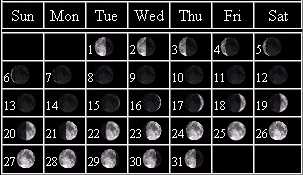|
The California
Varmint Callers Association
The first varmint hunting site on the net! The California Varmint Callers maintains this webpage for the benefit of all varmint and predator hunters.
|
||||
|
|
|
|||
 |
|---|
The lower towards the horizon the less time it will be visible. The moon's
phase will change during all this and though it may be directly overhead
it may just be a sliver or crescent and therefore not very bright. Determining
the exact moon phase with the rise and set times for any given day and location
on earth is a complicated mathematical process and beyond the scope of this
writing. If you want to plan your hunt with consideration to the moon phases,
there are a number of sources available that will
calculate
the moons ephemeris (position in the sky) and rise/set times for you.
Animal activity and moon phase are known to be related. The amount of light
available from the moon will determine the level of activity of many animals.
With a new moon , predatory animals have difficulty seeing at night and will
be less successful in feeding. Experience has shown that predators will respond
to calling a little better during days with a new moon. As the moon phase
progresses and the available night-time light level increases you may find
a corresponding decrease in the animals willingness to respond to your call.
This is not a hard and fast rule as other factors will affect the animals
willingness to respond to the call. Disregarding the moon phase for a moment,
as a general rule you will find most predatory animals active from the early
evening (around 1 or 2 hours before sunset) till about 11 or 12 at night
when their activity starts to slow down. Their activity will begin increasing
again around 3 or 4 in the morning while not slowing down again until around
10 or 11 in the morning. Again, there are no hard and fast rules in this
regard as you can find animals more or less active at all times of the day
or night. Regional, environmental factors play a big part in this.
In your area, numerous factors will affect the level of an animal's activity
and the current moon phase is just one of those factors (none-the-less an
important one). Animals will react in various ways to the conditions present
in their environment and knowledge of these factors and their affects on
an animals behavior can help you to determine the most productive times to
hunt. If you have done any amount of hunting at all you may have asked yourself
questions that every hunter sooner or later gets around to asking. "Why is
it that one day I go hunting and I see all kinds of animals and then the
next day can't find anything at all? There doesn't seem to be any rime or
reason to it"! No one, I think, has the pat answer to this question - this
writer included. But years of hard won experience by varmint hunters and
others have allowed us to draw a number of generalized conclusions regarding
animal activity.
Ask an experienced deer hunter if he will hunt after a night with a full
moon. The answer could easily be no. The reason for this answer lies in the
animals behavior and it's response to the surrounding environment. Nights
with a full moon or nearly a full moon will allow deer to see at night. They
may have been feeding all night and as result will be less active the next
morning. Remember, these are general conclusions and exceptions can always
be found. Almost all animals are preoccupied with gathering food and if they
can feed at night often will. The amount of hunting or predatory pressure
the animal experiences will affect it's behavior. In areas where animals
experience little hunting or predatory pressure you will most likely find
them feeding all day. The animal may have plenty of food available and have
little to fear from its surroundings. As a result they can afford to behave
in a leisurely manner. Baring a severe winter die off or deaths from disease
the animal populations in these areas naturally expand until some environmental
factor causes the population balance to be restored.
Environmental factors such as climatic conditions, available food supply
and competition from other animals will effect their population and level
of activity. Consider the caribou and its never ending trek across the frozen
north as an example of an animals response to its environment. They are always
moving, following the greening grasses for thousands of miles and then retreating
as the weather closes in on them. As with most animals, their behavior is
finely tuned to the ebb and flow of their environment. The caribou's predictable
set of behaviors are due to the clearly defined, abrupt and severe seasonal
changes it experiences. The caribou simply must behave the way it does or
die. Its range being so far north subjects it to environmental extremes most
other similar animals never experience. How many land based animals do you
know of in North America that migrate thousands of miles every year in response
to a changing environment? Game species with a more southern range don't
need to have the predictable set of behaviors of the caribou in order to
survive. The seasonal changes here, for the most part, are less severe.
Predatory animals are affected by the same ebb and flows of nature and in
addition, their behavior and populations are closely tied to their prey.
In the desert during midday it is simply too hot for any significant level
of activity. Predators will bed down and wait out the heat. When hunting
in the deserts you will, during certain times of the year, encounter windy
conditions. Experience has shown that when the wind kicks up the animals
bed down. Most experienced varmint hunters will pack it up and go home or
wait out the wind. There are of course regional differences in animal behavior
and those behavioral differences will be determined by the factors that affect
the animals chances of survival. In short, the animals will adopt those behaviors
necessary to ensure its survival. Even those animals with a developed sense
of night vision have difficulty seeing on nights with a new moon. You can
bet they will be more active the following morning. The morning after a few
days or even weeks of heavy weather followed by a night with a new moon may
be the most productive time of all. The bad weather has forced them to remain
bedded down and the dark nights have denied them the ability to feed at night.
The next available clear weather morning is the time you want to hunt. Sometimes
you can pick up various clues that can help you in determining the likelihood
of a successful hunt. I have been told by more than one experienced varmint
caller that if you see the cows bedded down that your hunting will not be
good. I am not sure of the reasons for this one but know it to be generally
true as I have experienced this myself. Another clue is the level of owl
activity the previous night. If you see a lot of owls active then your hunting
will not be good. Granted, a lot of this may sound like the typical "old
wives tale" but then many old wives tales have at least some basis in reality.
I suspect the reason for a correlation between owl activity and hunting success
may have to do with the fact that both owls and coyotes share a common food
source of mice and other small rodents. If there are few coyotes in a particular
area, the area may experience an increase in the rodent population. Naturally,
the owl will increase its numbers in taking advantage of this food supply.
Keep an eye out for kit fox. If you see a lot of kit fox in a particular area
you will find few coyotes. Here again, experience has show a correlation
between the numbers of kit fox and coyotes. I have seen kit fox and coyotes
together in the same area but not very often. Even the predominance of certain
plants can be an indicator to the numbers and varieties of animals you will
find in a given location. Keep in mind that these are generalizations learned
from years of varmint hunting and that you will occasionally find exceptions
to these rules. How well you are aware of, or how well you are tuned into
your environment will play a large part in the success of your hunts. In
determining the best time to hunt in your area it will help to know the weather
conditions, moon phases, available food supply, competition from other animals,
hunting pressures, the time of year, water availability, etc.

